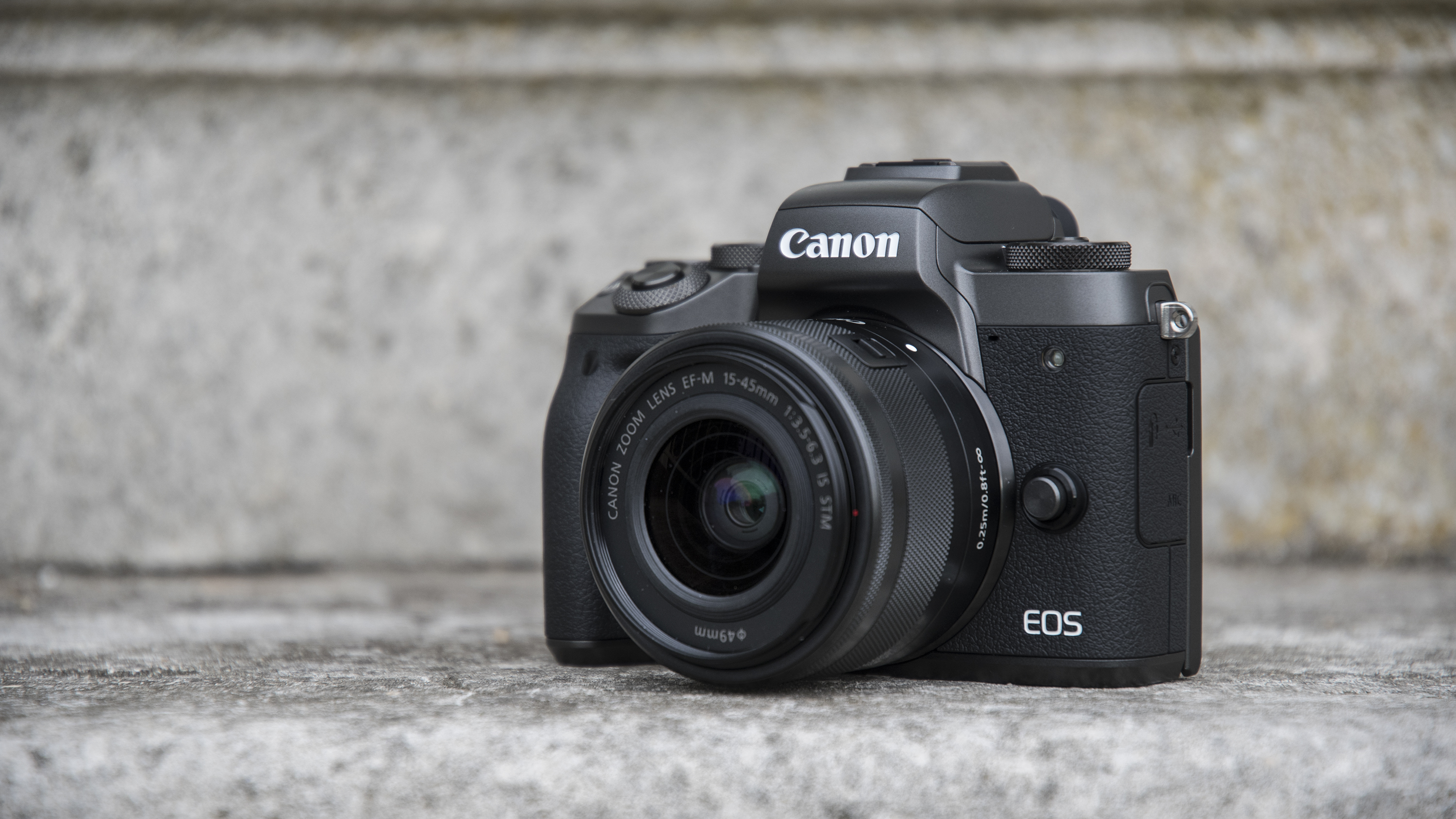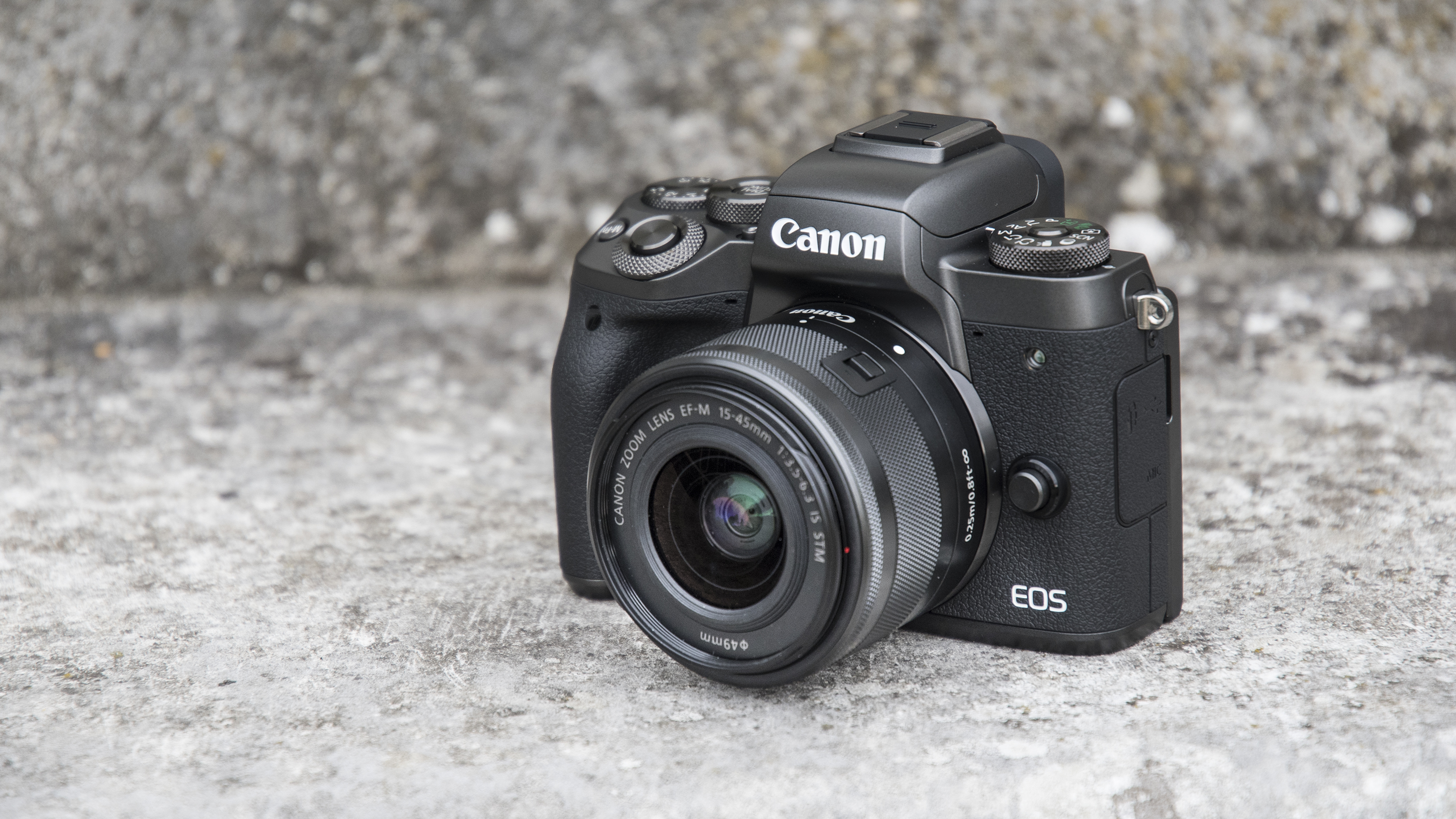Why you can trust TechRadar
Build and handling
- Polycarbonate construction
- Dial function button
- Weighs 427g
Rather than the compact-style look that previous EOS M series CSCs have followed, the EOS M5 looks like a mini DSLR, thanks in part to its built-in EVF sitting relatively central above the lens – there’s also a small built-in flash tucked away in the raised hump of the camera. It’s certainly very petite, but not so small that it’s an issue when you pick it up.
Taking its styling cues from both the EOS DSLR and mirrorless ranges, the subtle two-tone finish of the EOS M5 gives the camera a premium look, with the metallic grey matching that of the lenses in the EF-M range.
Despite appearances though, the chassis is constructed from strong polycarbonate and not aluminium alloy, and weighs in at 427g body-only with battery and card. In the hand, while there’s no getting away from the noticeable plasticky feel, especially when you tap the top plate, the modest grip is nice and comfy, with Canon's pleasing textured rubber coating enhancing the feel.

The EOS M5 is the most enthusiast-focused mirrorless camera we’ve seen from Canon to date, with numerous body-mounted controls. As we've seen on other EOS mirrorless cameras the shutter button is ringed by a front command dial, while there's an exposure compensation dial at the rear (similar to that seen on the likes of the Fuji X-T2).
Taking inspiration, though, from Canon’s range of G-series enthusiast compacts is the addition of a Dial Func. button, which is effectively a command dial with an additional button in the centre.
Whereas Canon DSLRs with top-plate LCDs have four buttons dotted along the top for access to ISO, WB etc, on the M5 you simply have to press this central button, which will then allow you to toggle through the settings (White Balance, ISO, Metering mode, AF mode and Drive mode), and select one by pressing the button again.
The setting you've selected is displayed either in the viewfinder or on the rear screen, and you then use the command dial to adjust the desired setting. In practice, it’s a system we have to say works very well, delivering a refined way of quickly accessing and adjusting a range of key settings.
As well as a rear scroll wheel control with four-way controls, there’s a decent degree of customisation available, and that’s not forgetting the touchscreen interface, which makes selecting desired settings and reviewing images that much more straightforward, while there are some clever tricks that allow for quick AF selection.
Autofocus
- 49-point AF system
- Phase-detection points built onto sensor
- One-shot AF and Servo AF
As we’ve mentioned, Canon’s original EOS M got quite a kicking for its sluggish AF performance. There was no issue with its accuracy; the problem was with the time it took to lock onto subjects, and it wasn’t anywhere near as snappy as its rivals. Things have improved since then with the M3 and M10, and the M5 things takes things up a sizeable notch.
The camera uses Canon’s latest Dual Pixel CMOS AF system, in which all the pixels on the surface of the sensor are made up of two separate photodiodes, which are read separately for phase-detection AF, and together for imaging.
We’ve been impressed with this system in the likes of the EOS 80D and 5D Mark IV, and it doesn’t disappoint in the EOS M5. Compared to the original EOS M, AF performance is almost unrecognizable.
Focusing is nice and quick, while the ability to touch and drag the AF point with your thumb on the rear display while you have the camera raised to your eye makes quick AF area selection very straightforward. You don't have to swipe across the whole screen either – if you want you can set this function to half or a quarter of the display in the menu.
Coverage is pretty good too, with 80% of the image area covered and 49 AF points at your disposal (on a grid of 7 x 7), while face and subject tracking can also be specified.
Current page: Build, handling and AF
Prev Page Introduction and key features Next Page Performance and image qualityPhil Hall is an experienced writer and editor having worked on some of the largest photography magazines in the UK, and now edit the photography channel of TechRadar, the UK's biggest tech website and one of the largest in the world. He has also worked on numerous commercial projects, including working with manufacturers like Nikon and Fujifilm on bespoke printed and online camera guides, as well as writing technique blogs and copy for the John Lewis Technology guide.

